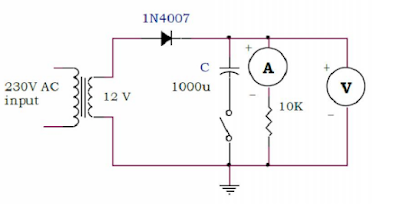Friday, December 13, 2024
Tuesday, December 10, 2024
Pr. Half Wave Rectifier
- Breadboard
- Ammemeter, Voltmeter
- Step Down Transformer
- Diode 1N4007
- Resistor 10K
- Capacitor 1000μF
- Oscilloscope
Monday, November 4, 2024
Privacy Policy
Thank you for choosing Alternate Classroom . This Privacy Policy explains how we collect, use, share, and protect your information when you use our App. By using the App, you agree to the practices outlined in this policy.
1. Information We Collect
- Personal Information: We may collect information like your name, email address, and school or grade level when you create an account. If applicable, we may also collect payment information if you subscribe to premium content.
- Usage Data: We collect information about your activity within the App, such as the pages you view, the content you interact with, and your preferences.
- Device Information: We may collect information about the device you use to access the App, including its IP address, operating system, and unique device identifiers.
2. How We Use Your Information
We use the information we collect for purposes including:
- Providing and improving the App’s features and services
- Customizing content and learning recommendations based on your preferences
- Responding to your comments, questions, and requests
- Notifying you of updates, new features, or other promotional information related to the App
- Analyzing usage trends to enhance user experience
3. Sharing Your Information
We do not sell or rent your personal information to third parties. We may share your information with:
- Service Providers: Third-party vendors who provide services such as data analysis, payment processing, and customer support, subject to confidentiality obligations.
- Legal Requirements: If required by law, we may share your information in response to legal requests or to protect the rights, property, or safety of our users or others.
4. Third-Party Analytics and Advertising
We may use third-party analytics tools (like Google Analytics) to help us understand how users interact with the App. These providers may use cookies or similar technologies to collect information on our behalf.
5. Children’s Privacy
Our App is intended for students, but we prioritize the protection of children’s privacy. If you are under 13, you must have parental consent to use the App. We do not knowingly collect personally identifiable information from children under 13 without verifiable parental consent. Parents or guardians may contact us to request the removal of their child’s information.
6. Data Security
We implement reasonable security measures to protect your information from unauthorized access, use, or disclosure. However, no method of electronic storage or transmission over the internet is completely secure, so we cannot guarantee absolute security.
7. Data Retention
We retain your personal information for as long as necessary to provide the App’s services and fulfill the purposes outlined in this policy, unless a longer retention period is required or permitted by law.
8. Your Choices and Rights
Depending on your jurisdiction, you may have certain rights regarding your personal data, including the right to access, correct, or delete it. You can contact us to exercise these rights or adjust your privacy settings within the App.
9. Changes to This Privacy Policy
We may update this Privacy Policy from time to time. If we make significant changes, we will notify you within the App or by email. Your continued use of the App after any updates constitutes your acceptance of the revised Privacy Policy.
10. Contact Us
If you have any questions or concerns about this Privacy Policy, please contact us at srijan.adhikary@gmail.com
Saturday, November 2, 2024
List of Probable Science exhibition Projects
1. Study of germs in the nearby water sources.
• taking water sample from different water sources (drinking and non drinking)
• keeping those in test tubes for 3 days
• Observing the water under microscope to detect any micro organisms and their identification.
2. Study of Germs in stale/ rotten food.
• taking sample of stale food and rotten fruits and observe the microorganism
• draw conclusion
• suggest for the preservation of food
3. Effect of moisture in growth of plant.
Take five nursery bags.
• fill all with the same soil
• plant seed of any plant (small e.g pea) in each.
• Properly irrigate till all the plant grow.
• After they grow apply different amount of water in each plant.
• Measure the length of plant in each week.
• Make conclusion.
4. Growth of plants towards light, moisture, against gravity.
5. Renewable Energy sources , hydro , solar.
• Construction of working model of hydropower
• Demo of solar energy with its working principle
6. Bio mass energy
7. Demonstrations of system of human, e.g circulatory, respiratory, digestive etc.
8. Model of solar system, eclipse,
9. Demonstration of different layer of earth and Volcano.
10. Different layer of atmosphere and green house effect
11. Soil erosion and demo of preventive measures.
12. Formation of soap
13. Different indicators from kitchen / interesting chemistry at kitchen
14. Formation of Alcohol.
15. Formation of hydrogen and use it in balloon.
16. Hydraulic machines
17. Making a simple lactometer to measure purity of milk
18. Solar water heater.
19. Working model of microscope, telescope
20. Demo of Total internal reflection, optical fiber
21. Solar cooker
21. Model of electric motor and generator
22. Gas leakage sensor using MCQ 2
23. Fire alarm
24. Automatic movement of sun dried clothes when it rains
25. Automatic irrigation system
26. Automatic ripen fruit selection system
27. Counter system for people entrance/ item production at factories.
28. Cable car / Rope way
29. Smart dustbin
30. Magnetic levitated train.
31. Podway: A new means of transportation.
32. Rope way using gravity (without electricity)













